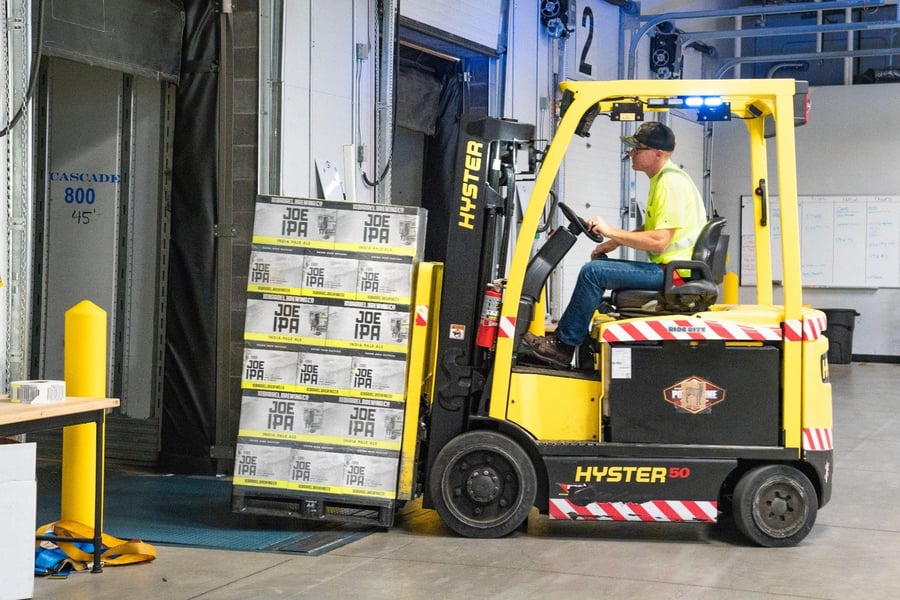
In the world of eCommerce, there are several popular models for the order fulfillment process. These include merchant fulfillment, third-party fulfillment, and dropshipping. Many eCommerce retailers employ more than one model of order fulfillment in order to optimize the process for different products and customers.
In order to help your eCommerce business grow, it’s important that orders are fulfilled promptly and in a way that delights your customers. The following seven tactics can be used by any eCommerce retailer that wants to deliver the kind of exceptional customer experience that will have people coming back again and again.
1. Measure order fulfillment cycle time.
The fulfillment cycle time of an order is the amount of time taken between someone placing an order and them receiving that order. The basic formula for measuring order fulfillment cycle time looks like this:
Total order fulfillment cycle time = source time + production time + delivery time
Source time is the first stage of the order fulfillment process. It’s the time between a customer making an order and your business placing its own consequent orders. This could be either placing orders internally or with other suppliers.
Production time is the time taken to manufacture, pick, pack, and prepare the order for shipping. This is where most of the variance can be found due to the fact that different product types require different amounts of time to manufacture and prepare.
Many eCommerce retailers have a manufacturing time of zero as the products they sell are manufactured by someone else. In such cases, the majority of production time consists of locating the items in a warehouse if you keep them in stock or by ordering from your supplier if you don’t.

Delivery time refers to the time between an order leaving your warehouse and the moment it arrives at the customer’s specified delivery location.
Measuring order fulfillment cycle time and tracking your average cycle time is the best way to stay on top of your supply chain and to ensure that every aspect of order fulfillment is being carried out effectively.
Benchmarks for a good fulfillment cycle time will inevitably vary depending on the specific products you sell. While many online sellers now offer same-day delivery or next-day delivery, if you include a lengthy manufacturing time in your fulfillment cycle, it could easily stretch on for weeks or even longer in some cases.
A good indicator of whether your fulfillment lifecycles are of a reasonable length or if they’re not meeting the necessary standards is to compare your promised customer order cycle time with your actual customer order cycle time.
If you’re consistently beating the promised cycle time, that suggests your processes are functioning smoothly and in a timely manner. If, on the other hand, you find that actual cycle time is frequently longer than the promised cycle time, you should investigate what’s slowing down the cycle and look into improving that part of the order fulfillment process.
2. Keep your stock organized.
The optimal way of organizing your stock will vary depending on the physical properties of the products you sell, the layout of your warehouse(s), the location of your warehouse(s), and the demands of your customers.
One of the major advantages of eCommerce over other forms of retail is that it leaves less room for human error when it comes to inventory management. Organization then becomes a matter of mapping digital inventory diagrams onto real-world logistical operations.

One simple way to organize your stock is to classify your inventory according to sales volume. As well as helping you to ensure you don’t miss out on sales by running out of a popular product, this approach to stock organization can be applied to the challenge of efficiently designing your warehouse floor plan.
3. Incorporate marketing.
The order fulfillment process is an opportunity to prove the value of your brand to shoppers. Turn one-time buyers into repeat customers by aligning your marketing efforts with your order fulfillment process.
Including promotional material with each shipment is an easy way to add marketing to every order that takes very little effort but can help to increase your brand visibility. Just think about it. Something as simple as throwing a sticker in with each order doesn't cost much or take more than a few seconds per order. Yet that sticker could end up being displayed somewhere where it gets seen by hundreds of potential customers.

Look out for good co-marketing partners too. This strategy involves partnering up with another business that isn’t a competitor but with whom you share an overlapping target market. They send out your promotional material, and in turn, you distribute some of theirs. The best co-marketing campaigns include freebies and unique offers. This turns what could be seen as just a wad of advertisements into something worthwhile.
4. Assess your logistics strategy.
If you’ve been working with the same delivery service for years, the prospect of changing can seem daunting, but it's definitely worth asking yourself whether your logistics partners are offering the best value for money.
Consumer preferences and the offerings of different shipping providers change. Reassessing your logistics strategy at yearly intervals is the best way to ensure the couriers and delivery companies you work with are providing the service most suited to your product range and customers.
For example, if you’re selling on Amazon, you have the option to fulfill orders yourself or to send products to an Amazon warehouse and let them deal with order fulfillment. Amazon’s current fee structure makes the first model (known as fulfillment by merchant, or FBM) preferential for larger products with a lower sales volume.
On the other hand, small, lightweight products that sell in larger quantities can generate more revenue if you pursue the second option, known as fulfillment by Amazon (FBA).

The choice of FBM versus FBA is just one example of logistical dynamics that can be optimized for any given product at any given time. In recent years, the range of sales and delivery options on offer from platforms like eBay and Etsy has grown. Unless you’re running a purely first-party sales funnel, it pays to adapt your eCommerce strategy to be in line with the latest platform fees and consumer preferences.
5. Automate routine processes.
One of the significant benefits of eCommerce generally is that it lends itself to the automation of the order fulfillment process.
Payment is one aspect of the eCommerce order fulfillment process that can easily be automated. If you’re not taking advantage of one-click payment options, you’re only making it less likely that visitors to your online store will convert into paying customers and increase your abandoned cart rate.
These days, there are plenty of digital tools designed to help you automate otherwise tedious tasks as part of your order fulfillment process. For example, a number of Shift4Shop apps work as out-of-the-box automations that enhance your fulfillment process.
It’s easier than ever to automatically send text messages to your customers when their order has been processed and dispatched. In coordination with your shipping partner, both your customers and warehouse team can be notified when delivery has been made too.
Ensuring your software stack is properly integrated will also help to reduce friction between tasks and automate routine processes.
With the right software in place, you can have your order data plugged directly into your inventory management system for your warehouse team to fulfill, box, and ship. Improve your employee efficiency and save time by syncing your payment tools, CRM, inventory management software, and accounting software.
6. Make your returns policy attractive
If a buyer wants to return a product after purchasing it, either for a refund or an exchange, that counts as part of the transaction too. Although sometimes overlooked, returns are an important part of the order fulfillment process. Moreover, they are a key component of successful eCommerce sales.
With a return rate typically much higher than their in-store purchase equivalents, it makes sense that eCommerce returns policies are one of the major factors that people consider when deciding whether to buy something or not.

In one piece of consumer research, Klarna found that 78% of shoppers would buy more in the long run if a retailer had free returns. While in its 2020 Delivery Matters survey, Royal Mail found that 59% of respondents would be unlikely to shop with a particular retailer again after a difficult returns experience.
Rather than thinking of returns as an annoying expense, incorporate them into your customer onboarding template, and utilize them to boost your brand’s credibility and build stronger relationships with your customers.
7. Have a formalized quality assurance program in place.
Implementing protocols and standards for quality assurance checks is essential if you want to stay on top of your order fulfillment process and guarantee your customers receive a quality product and a high level of service every time.
As your eCommerce business grows, consider getting ISO certified to improve operational performance across your company. ISO certification can also help prove to consumers and business partners that you have the right quality management standards in place.
ISO 9001 and ISO 1008 both relate to quality management and have been broadly applied across the eCommerce industry. Ecommerce retailers are also increasingly turning to ISO 27001, which is intended to help organizations implement an information security management (ISM) system. An ISM system works to improve data security and protect customers’ personal information from cyber threats.

Conclusion
Ultimately, order fulfillment for eCommerce retailers functions differently from the fulfillment process for traditional merchants operating out of a brick-and-mortar store.
For starters, eCommerce imposes an entirely different sort of relationship with your customers. One of the biggest challenges online merchants face is building the kinds of relationships based on trust and reciprocity that come so naturally to local, in-store businesses.
What’s more, when selling online, you are far more likely to rely on third-party contractors and outsourcing elements of the fulfillment process. This gives you less control over the total order fulfillment process and means you have to have faith in your partners to deliver the agreed-upon service.
It can be tempting to simply choose the cheapest option when it comes to tasks like packing and delivery, but this route isn’t always worth it if it comes at the cost of customer satisfaction. Optimizing the order fulfillment process for eCommerce is about weighing the cost and benefits of your strategic business decisions.
When making changes to your business processes, always put yourself in the shoes of your customers and ask, “How will this affect the overall experience of transacting with my business? Will it improve or worsen the customer experience? And what are the costs and benefits of any changes you want to make?”





Leave a reply or comment below